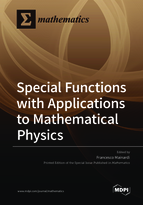Special Functions with Applications to Mathematical Physics
A special issue of Mathematics (ISSN 2227-7390). This special issue belongs to the section "Mathematical Physics".
Deadline for manuscript submissions: closed (31 December 2021) | Viewed by 52437
Special Issue Editor
Interests: special functions; fractional calculus complex analysis; asymptotic methods; diffusion and wave propagation problems
Special Issues, Collections and Topics in MDPI journals
Special Issue Information
Dear Colleagues,
This Special Issue includes theories and applications of high transcendental functions mainly included in the list of keywords:
- Mittag–Leffler and related functions, and their applications in mathematical physics;
- Wright and related functions and their applications in mathematical physics;
- Exponential Integrals and their extensions with applications in mathematical physics;
- Generalized hypergeometric functions and their extensions with applications.
However, this Special Issue is not limited to the above list, when the content of a paper is clearly related to some high transcendental functions and their applications. Special attention is reserved for the special functions exhibiting some relevance in the framework of the theories and applications of the fractional calculus and in their visualization through illuminating plots. Both research and survey pages are well accepted.
Prof. Francesco Mainardi
Guest Editor
Manuscript Submission Information
Manuscripts should be submitted online at www.mdpi.com by registering and logging in to this website. Once you are registered, click here to go to the submission form. Manuscripts can be submitted until the deadline. All submissions that pass pre-check are peer-reviewed. Accepted papers will be published continuously in the journal (as soon as accepted) and will be listed together on the special issue website. Research articles, review articles as well as short communications are invited. For planned papers, a title and short abstract (about 100 words) can be sent to the Editorial Office for announcement on this website.
Submitted manuscripts should not have been published previously, nor be under consideration for publication elsewhere (except conference proceedings papers). All manuscripts are thoroughly refereed through a single-blind peer-review process. A guide for authors and other relevant information for submission of manuscripts is available on the Instructions for Authors page. Mathematics is an international peer-reviewed open access semimonthly journal published by MDPI.
Please visit the Instructions for Authors page before submitting a manuscript. The Article Processing Charge (APC) for publication in this open access journal is 2600 CHF (Swiss Francs). Submitted papers should be well formatted and use good English. Authors may use MDPI's English editing service prior to publication or during author revisions.
Keywords
- Mittag–Leffler and related functions, and their applications in mathematical physics
- Wright and related functions and their applications in mathematical physics
- Exponential integrals and their extensions with applications in mathematical physics
- Generalized hypergeometric functions and their extensions with applications






